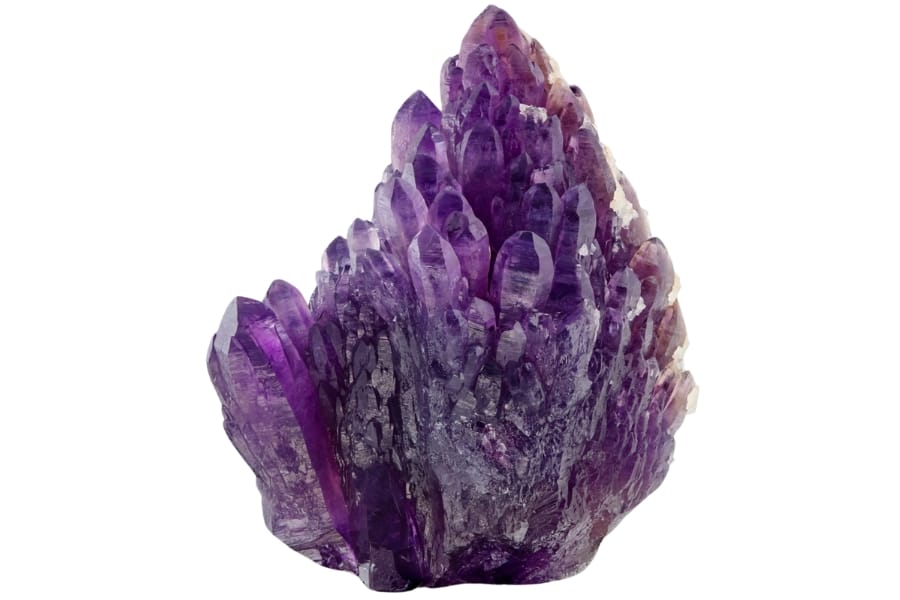South Carolina is known for having an amazing variety of rocks, fossils, and gems. Each piece has a story to tell—a natural story about how things change over time.
Many of these natural wonders can be found in the state’s many settings, from the majestic Blue Ridge Mountains to the peaceful coastal plains.
No matter how skilled you are, anyone can join the journey. As you walk through a nearby creek or on a hike in the woods, you might find something amazing.
We’ll look at an interesting list of rocks, gems, and minerals that you can find in South Carolina in this article. You will learn how to find these riches and where to look for them.
A List of The Common Rocks, Stones, and Minerals Found in South Carolina
First, we’ll discuss some of the state’s most well-known rocks and minerals. Click on the links below to read the full guides, which go into a lot of detail:
The South Carolina State Rock, Mineral, and Gem
Here is the list of South Carolina’s official state minerals.
| South Carolina State Rock | Blue Granite |
| South Carolina State Mineral | None |
| South Carolina State Gem | Amethyst |
Visit the site of the South Carolina Department of Natural Resources (DNR) to learn more about the state’s geology policy.
Always Confirm Access and Collection Rules!
Before heading out to any of the locations on our list you need to confirm access requirements and collection rules for both public and private locations directly with the location. We haven’t personally verified every location and the access requirements and collection rules often change without notice.
Many of the locations we mention will not allow collecting but are still great places for those who love to find beautiful rocks and minerals in the wild without keeping them. We also can’t guarantee you will find anything in these locations since they are constantly changing.
Always get updated information directly from the source ahead of time to ensure responsible rockhounding. If you want even more current options it’s always a good idea to contact local rock and mineral clubs and groups
Biotite
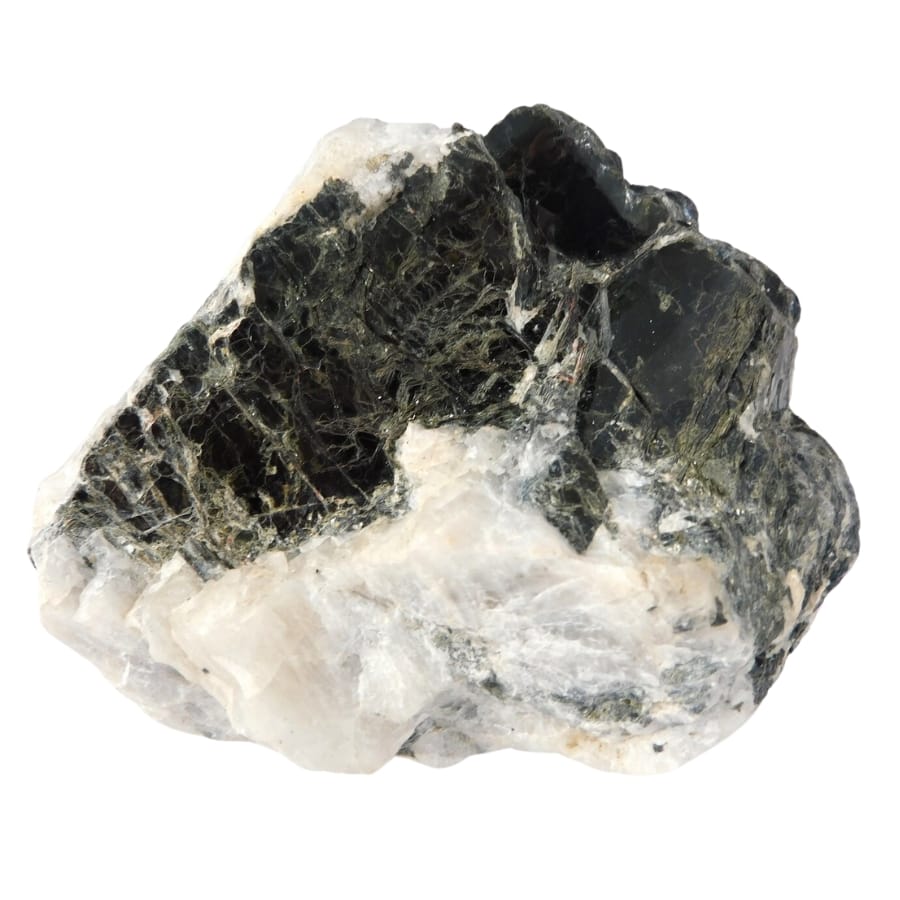
Biotite is a mineral that belongs to the mica family. Mica minerals are known for being able to separate into thin, flexible sheets. Usually black or dark brown, it looks shiny and glassy, which makes it stand out.
If you find biotite, you may notice that its sheets can be peeled apart like book pages. This one-of-a-kind trait makes biotite easy to spot. People often find biotite in igneous and metamorphic rocks.
It’s made at very high temperatures, usually when magma (molten rock) cools down. When magma cools down and turns into rock, biotite is often one of the minerals that form crystals.
They can form in metamorphic rocks when other rocks are heated and pressed for a long time. The original rock is changed into a new type by this process.
It can be found in many states, mostly in the Piedmont and Blue Ridge regions. It shows up here in granite and gneiss, common rocks in this area.
There are different reasons why people like biotite. This mineral is essential to scientists and geologists because it helps them figure out how the rock it’s found in formed.
Where you can find Biotite in South Carolina
Biotite can be commonly found in the Piedmont and Blue Ridge regions. These areas are known for their rich geological diversity and are part of the larger Appalachian Mountains range.
Copper
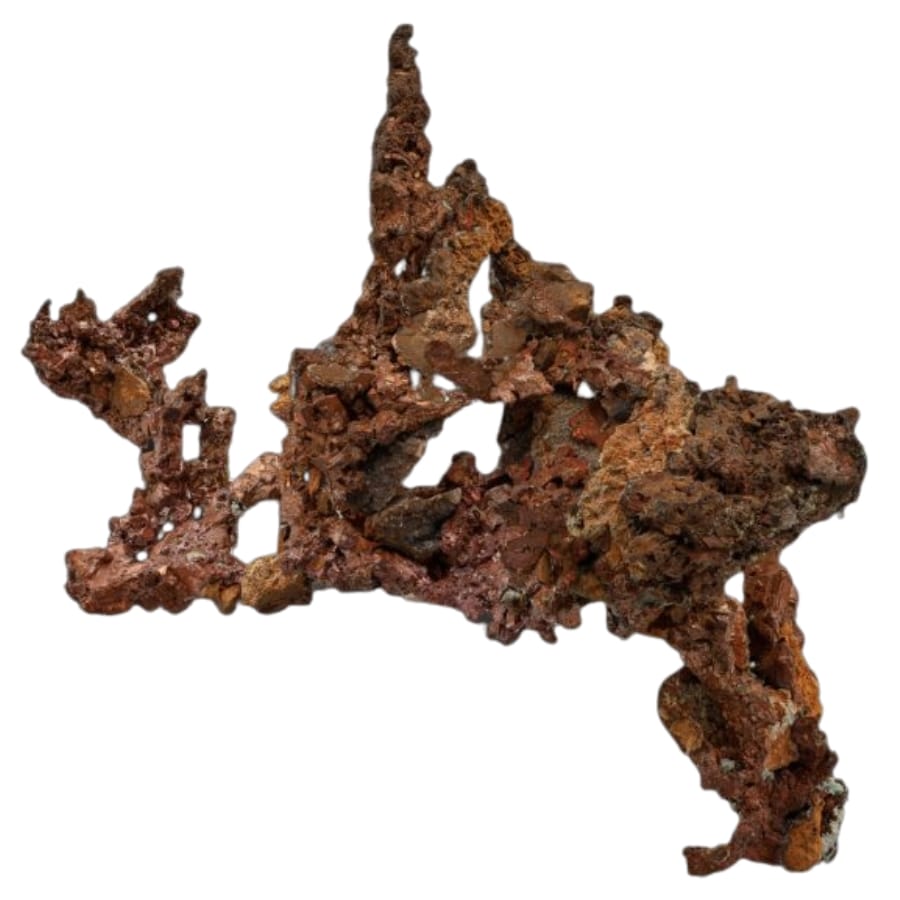
You may have seen copper in wires or pennies. It’s an excellent and essential metal. Being a great carrier of electricity means electricity can easily flow through it. It’s known for being shiny and a reddish brown color.
This metal can last very long because it’s bendable and doesn’t rust. People have been making things from it, from coins to pots and pipes, for a long time.
Heat and mineral-rich waters rise from deep within the Earth and cool down. This is how copper is made. Although these fluids are still hot, it begins to separate from the other minerals and makes copper deposits.
There are many reasons why people value copper. Also, it’s important for making alloys, which are metal mixes. Wires and pipes can’t be made without it. You can make bronze by mixing copper and tin, for instance.
Additionally, copper is very good for the earth and is utilized in various eco-friendly technologies, including solar panels and electric cars. That’s right, copper isn’t just pretty; it’s also very useful!
Where you can find Copper in South Carolina
You can find copper deposits at the Nott Mine in the state.
Epidote
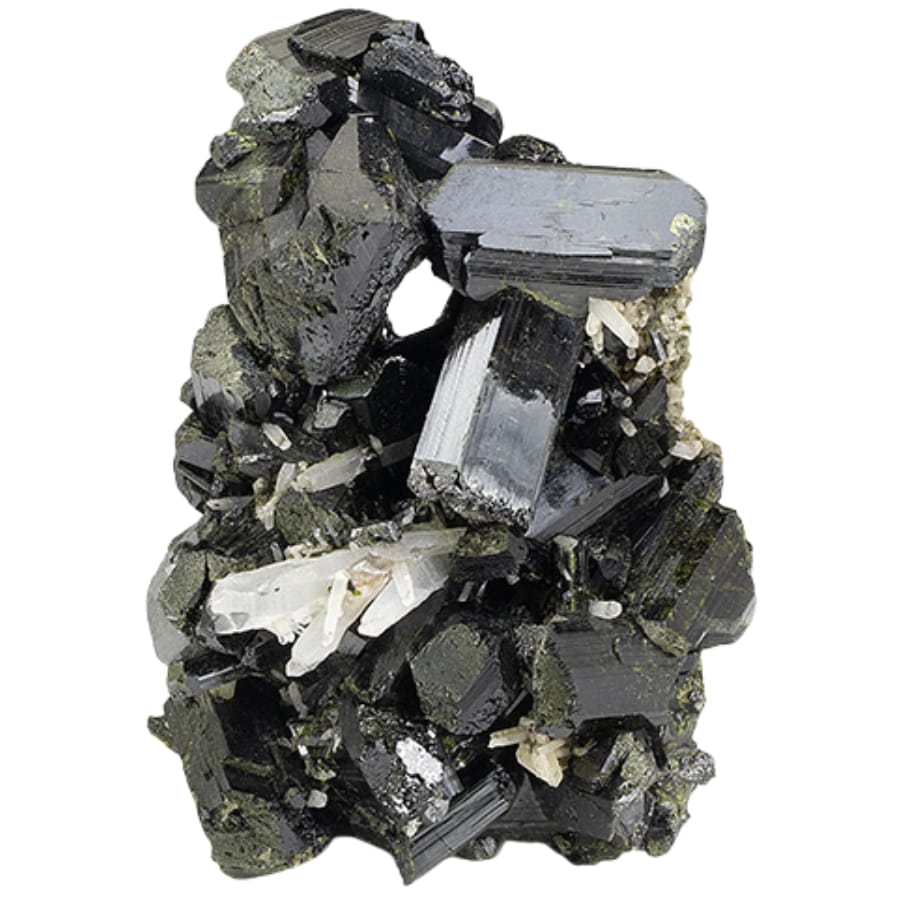
Epidote is a unique and interesting gemstone that isn’t as well known as others, but you should learn about it. It’s usually green, and the shade can range from bright lime green to almost black-green.
It’s known for having long, thin crystals that can look like tiny green needles. Sometimes, you can find this mineral in rocks that have been changed by heat and pressure. This is called metamorphism.
It’s cool how epidote forms. It generally happens when rocks high in calcium, like limestone, change shape. So, they are exposed to very high temperatures and pressures deep inside the Earth, which often happens when plates move.
The rocks are changed by this harsh climate, which lets minerals form. Igneous rocks, which are rocks that formed from lava or magma that has cooled, can also sometimes have epidote in them.
A lot of metamorphic rock can be found in the state’s Piedmont area, where it’s usually found. The epidote found here don’t always grow into big, perfect crystals, but they still have that green color and can be very pretty.
Where you can find Epidote in South Carolina
You can find epidote minerals at the Diamond Hill Mine.
Gneiss
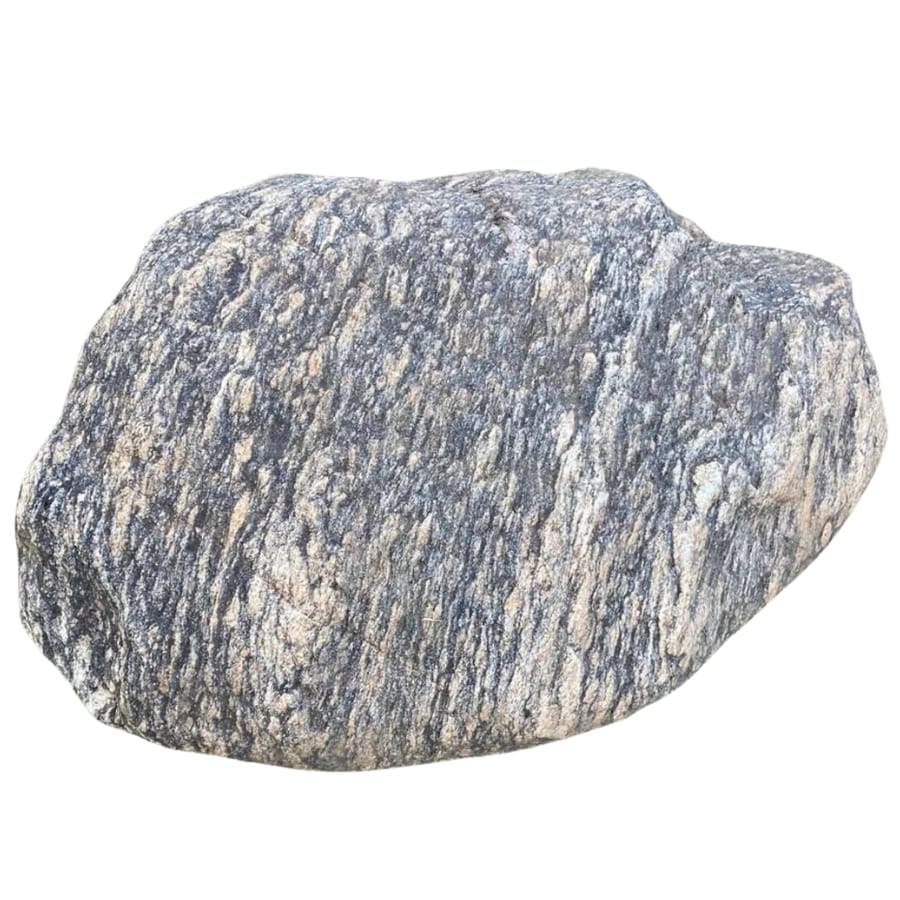
A rock called gneiss (pronounced “nice”) is very common, but you may not have heard of it. It has layers or bands of different colors and types of rocks that give it a pretty unique look. This kind of rock has bands that can look like straight lines or stripes.
There are a lot of different colors that can be found in gneiss, but they are usually some shade of gray, white, pink, or even dark black. People often choose this rock for building and decorating because it’s very hard and lasts long.
A fancy word for the process by which gneiss is made is metamorphism. It’s made up of rocks that have been changed by very high temperatures and pressures deep inside the Earth. It takes a very long time for this to happen.
Glacier and sedimentary rocks get hot and squished when pushed into the Earth’s crust. This makes the minerals in the rock move around, creating the layers and bands that make gneiss stand out.
Gneiss in the state can be very pretty, and it’s often used in building and gardening, for example, to make stone walls or garden boulders that look nice.
Geologists study it to learn how the Earth’s crust formed and how it has changed over time. It’s also a great rock for teaching kids about geology and rock creation because it’s so strong and lasts a long time.
Where you can find Gneiss in South Carolina
There are many places in the state where you can find gneiss. One of these is the Paris Mountain State Park.
Hornblende
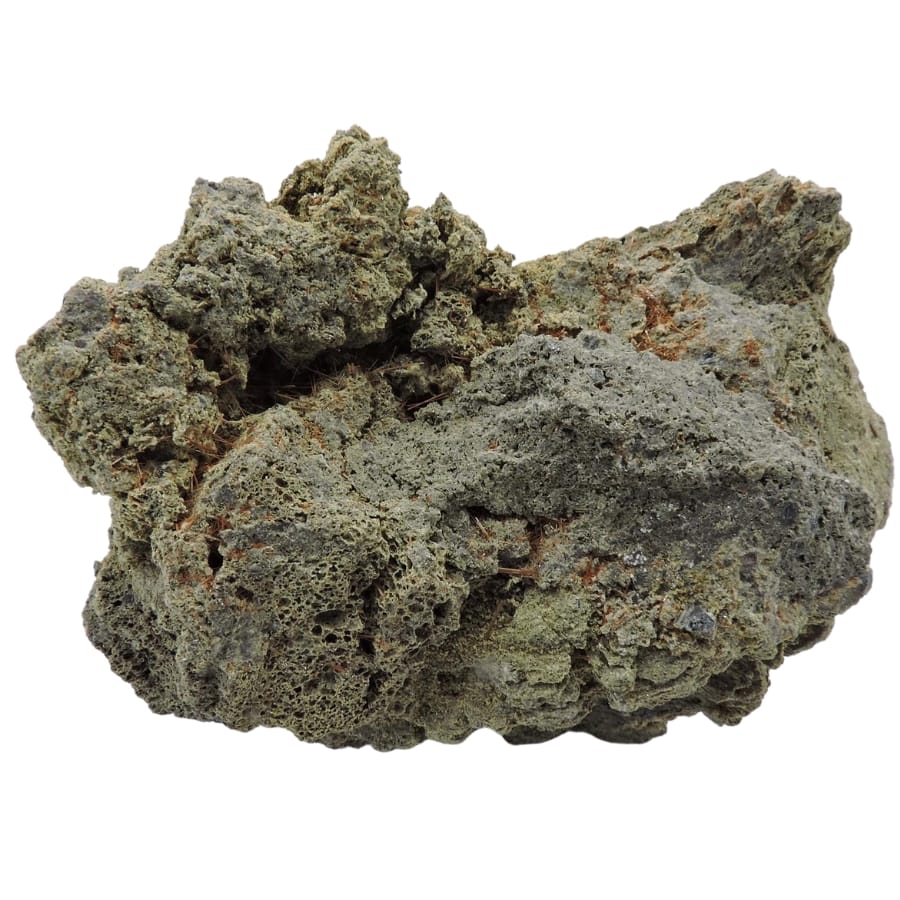
Hornblende is a bunch of minerals that are sort of the same. Sometimes it’s dark green, brown, or black and looks like glass. It often forms in long, thin crystals that can look like black needles.
It’s found in many types of rocks, but it’s most common in rocks made from lava or magma, which are molten rocks inside the Earth. It’s also found in metamorphic rocks, which have been changed by heat and pressure.
There are several ways that hornblendes can form. When lava or magma cools down and turns into rock, that’s one way. It can grow in the rock as it cools, making those cool diamonds.
When something changes, it goes the other way. Rocks that are already formed do this when hidden deep in the Earth. They get very hot and are squished under a lot of pressure, which can change the chemicals in the rock.
There are several reasons why people like hornblende. This rock is popular with rock lovers because the crystals are dark and shiny.
In some types of rocks, it can make the rock more complex and less likely to break. This is useful for building and making countertops.
Where you can find Hornblende in South Carolina
Hornblende can primarily be found in the Piedmont and Blue Ridge regions.
Schist
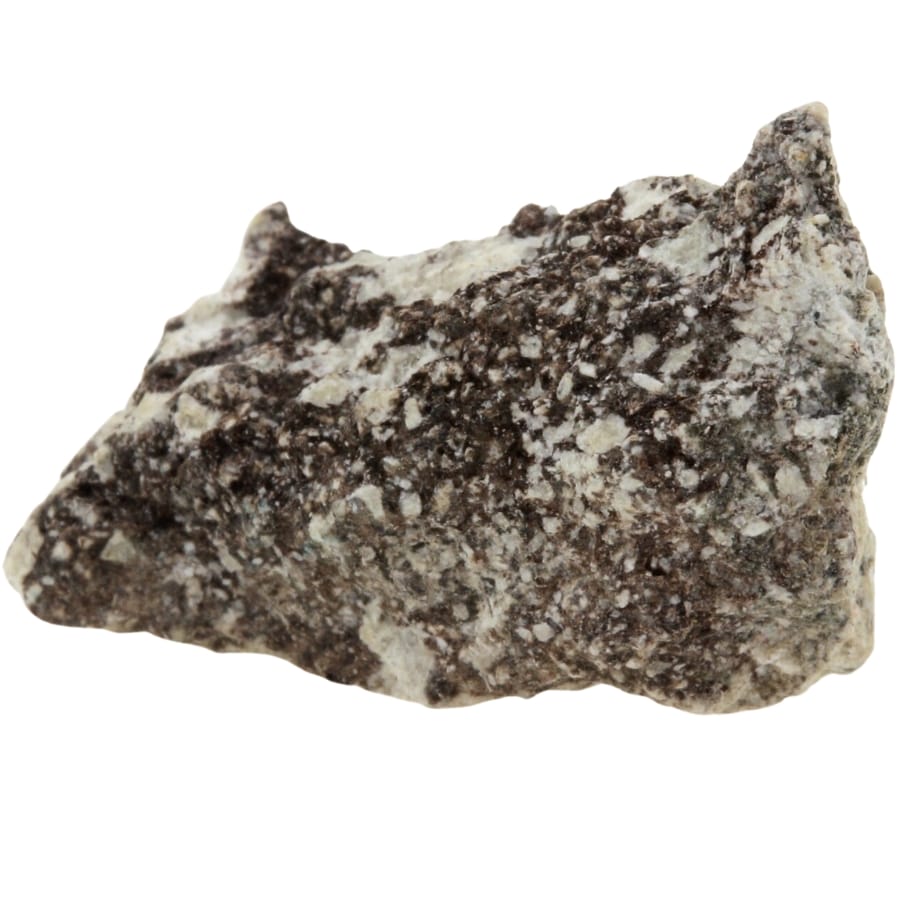
There are many thin layers and shiny bits inside the schist, which makes it a very interesting rock to look at. Silver or gold, pink or green, or any color in between because these layers comprise different minerals, such as mica, garnet, and quartz.
Light bounces off rocks like mica’s flat surfaces, giving schist its shiny look. So the rock has many layers because it usually comes from places where the Earth’s crust has been under a lot of pressure and heat.
Geology in some parts of the state has changed significantly over millions of years. This makes those areas great for finding metamorphic rocks like schist. There are different reasons why people like schist.
It’s used in gardening and building because it looks nice and can easily cut into flat pieces. Also, rock fans can get very excited when they find a piece of schist with many different minerals in it.
Where you can find Schist in South Carolina
You can find schist in these areas in the state:
- Clearwater
- Paris Mountain State Park
The Gemstones Found In South Carolina
Let’s talk more about South Carolina’s gems. We’ve also put together a list of our most in-depth articles in case you want a full guide:
Andalusite
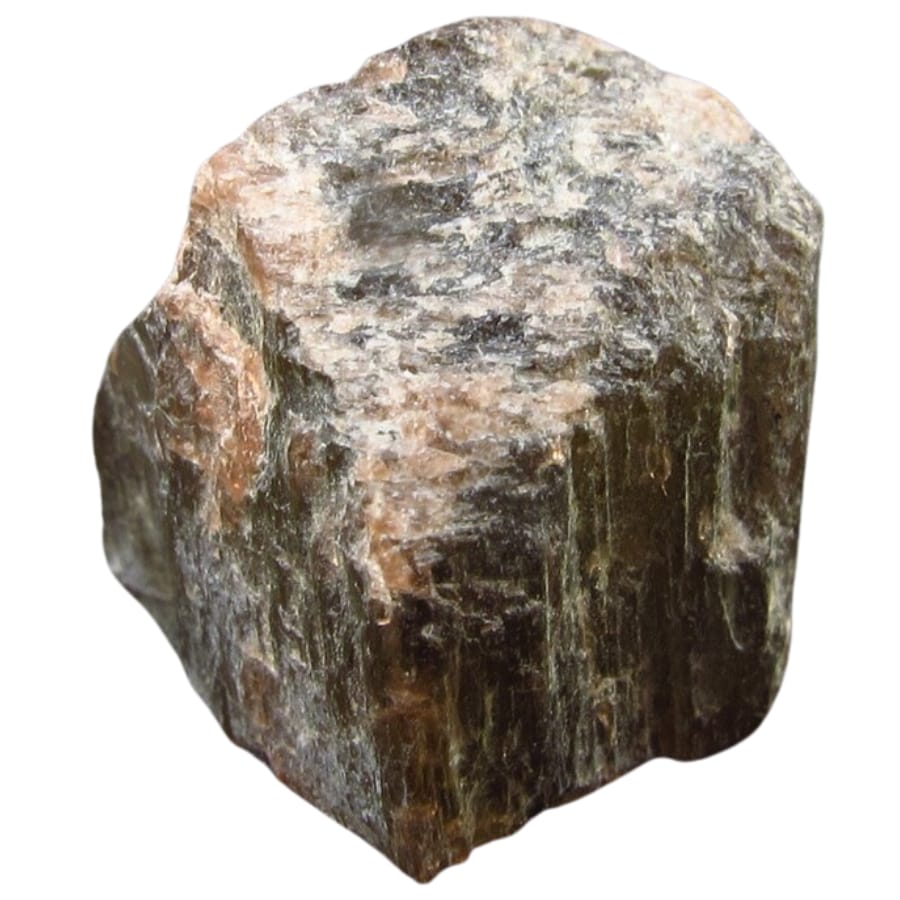
It’s not as well known as diamonds or gold, but andalusite is a really fascinating mineral in its own way. It usually has shades of pink, orange, green, or brown, but the light can sometimes make it change colors.
Interesting thing about andalusite is that it usually makes long crystals that look like columns. There are times when these crystals have a cross-shaped design inside them.
It’s made when rocks that are high in clay are heated up without being pressed too hard. This often takes place near the edges of tectonic plates, which are places on Earth’s surface where the rock is moving and changing.
The clay minerals change into andalusite when these rocks are hidden and get hot. These changes happen because of metamorphism, a fancy word for how rocks change when they’re hot and pressed together.
It’s valuable for people who make jewelry. Because of its unique colors and the way it can look different from different angles, andalusite can be cut into beautiful gemstones.
Where you can find Andalusite in South Carolina
This is where you can find andalusite in the state:
- Henry’s Knob
Aquamarine
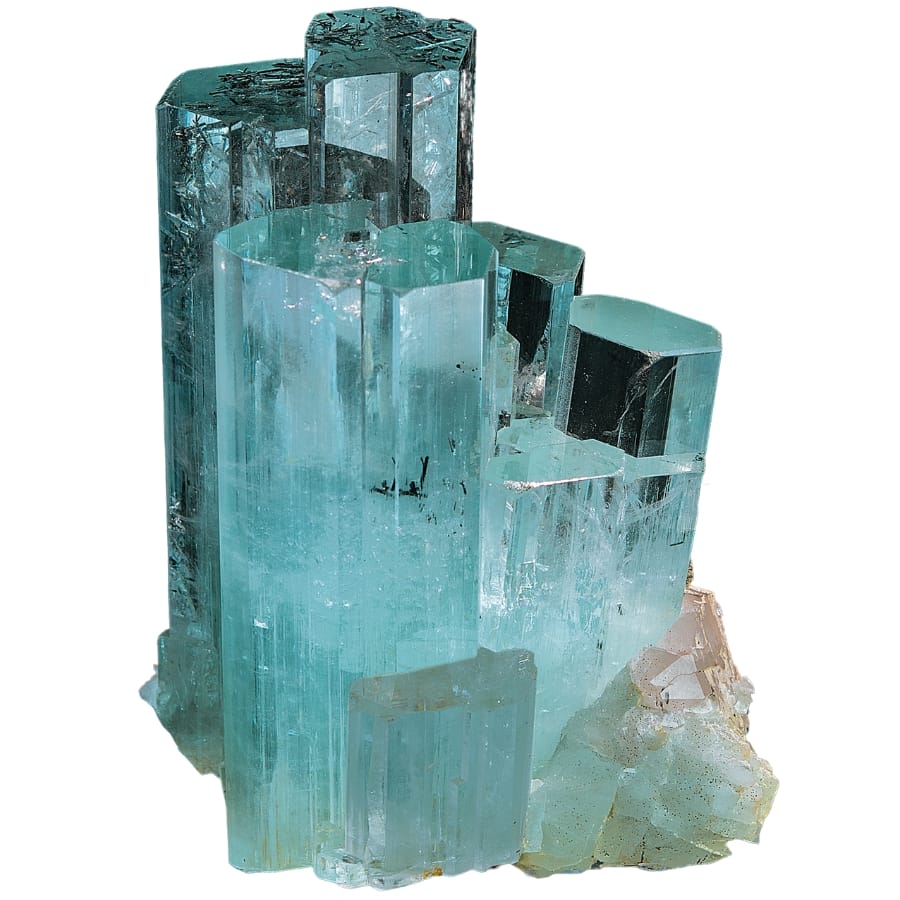
Aquamarine is a pretty gemstone that’s known for its beautiful blue to blue-green color. Like emeralds, aquamarine is a type of beryl, which is a mineral made up of beryllium, aluminum, silicon, and oxygen.
The color of aquamarine comes from iron. The shades can range from a very light blue to a deeper blue, almost like the sea. That’s actually how it got its name – “aquamarine” means “water of the sea” in Latin.
These gemstones are usually found in clear, transparent forms, and they can be really sparkly when they’re cut and polished.
It can look like a piece of the ocean stuck inside a rock, which is one of its coolest qualities. It’s usually found as a crystal. The crystals are big, making them great for cutting into gems.
Pegmatites are a type of rock that forms when magma cools down. Different crystals crystallize as the magma cools, and beryl can be one of them.
When iron is added to beryl, it turns the beautiful blue color we know as aquamarine. It will take between a few thousand and a few million years!
Aquamarine is valuable because it’s often used to make rings, chains, bracelets, earrings, and more. Many people like aquamarine because it looks great in many different styles.
Where you can find Aquamarine in South Carolina
The following are where you can locate aquamarine minerals:
- Coastal Gem Mining
- Greenville Gemstone Mine
- McConnell Mica Prospect
- Savannah River Bank
Barite
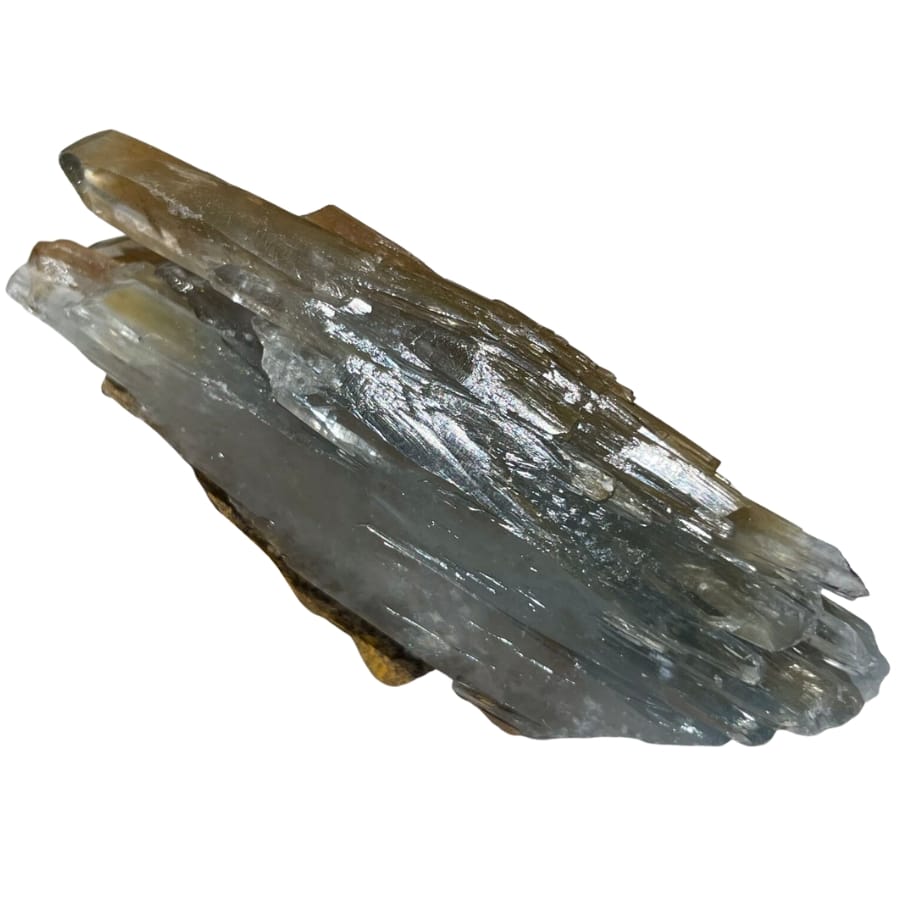
Barite, which is made up of barium sulfate, a combination of barium, sulfur, and oxygen. It comes in a number of colors, such as white, yellow, blue, and gray. For an element that isn’t metal, it’s pretty heavy.
One thing that makes it stand out is its high density. Minerals can take on many shapes, from flat crystals to flexible, blocky, or even earthy ones. In many places, you can find barite, but most of the time it is found in hot springs or sedimentary rocks like limestone where there has been geothermal activity.
It can form in the ocean or big lakes with a lot of sulfate, which is a salty substance. Barite is made when this sulfate and barium mix in water. This barite can get into rocks over time and stay there for a long time.
There are many reasons why people find barite very useful. The oil and gas industry uses it frequently because it’s heavy. You can also use it to help keep the digging safe and under control when they go deep into the ground to look for oil or gas.
Barite is also used to add weight to paint and metals. Plus, it blocks X-rays and gamma rays very well, which is why it’s used in protective clothes like the aprons doctors wear during X-rays.
Where you can find Barite in South Carolina
You can find an abundance of barite deposits at King’s Creek.
Emerald
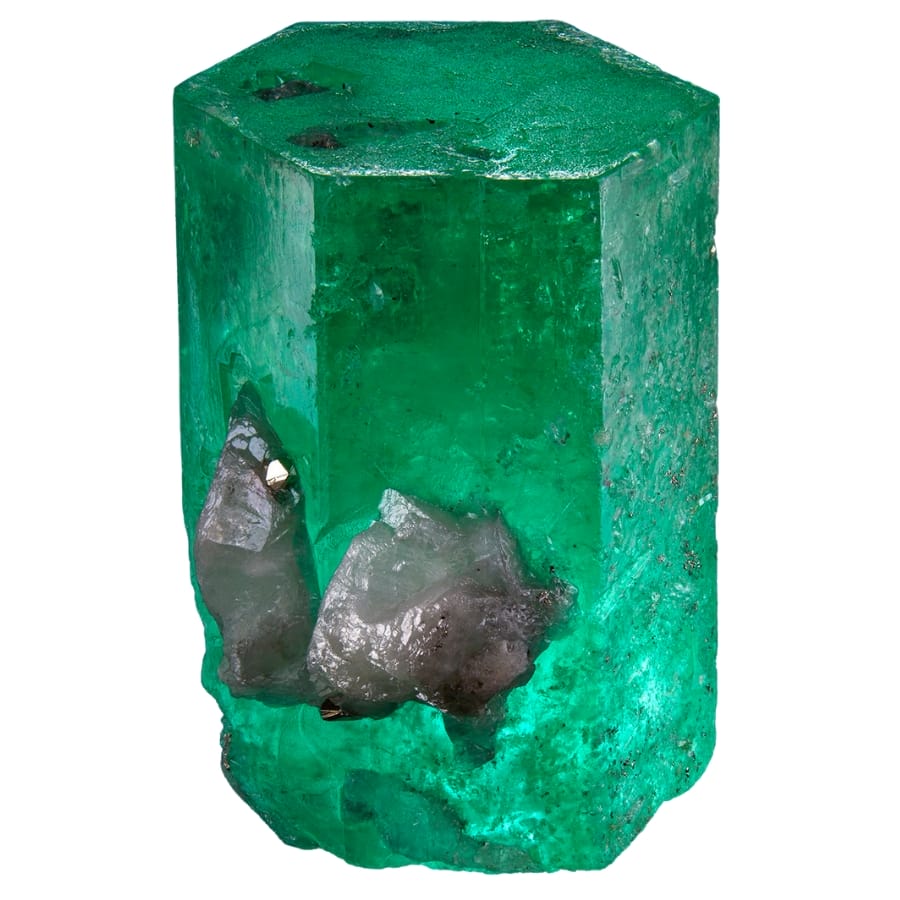
One thing that makes emeralds stand out is their beautiful green color. In fact, they are a type of beryl, which is a gemstone made up of beryllium, aluminum, silicon, and oxygen.
Emeralds are green because they have small amounts of chromium and sometimes vanadium in them. You can find these gems in a range of green shades, from light to very dark. They aren’t found very often compared to other gems, and they often have tiny natural marks or inclusions that make them special, like fingerprints.
Emeralds are very valuable and are often used to make rings, bracelets, and earrings. In many countries, emeralds are seen as very valuable signs of wealth, power, and beauty.
They have also been used in more than just jewelry; like in historical artifacts and things. Even though emeralds are mostly used in jewelry these days, they are still one of the most sought-after rocks in the world.
Where you can find Emerald in South Carolina
Emeralds can be located in these spots around the state:
- Bowen’s River
- Broad River
- Coastal Gem Mining
- McConnell Mica Prospect
Lazulite
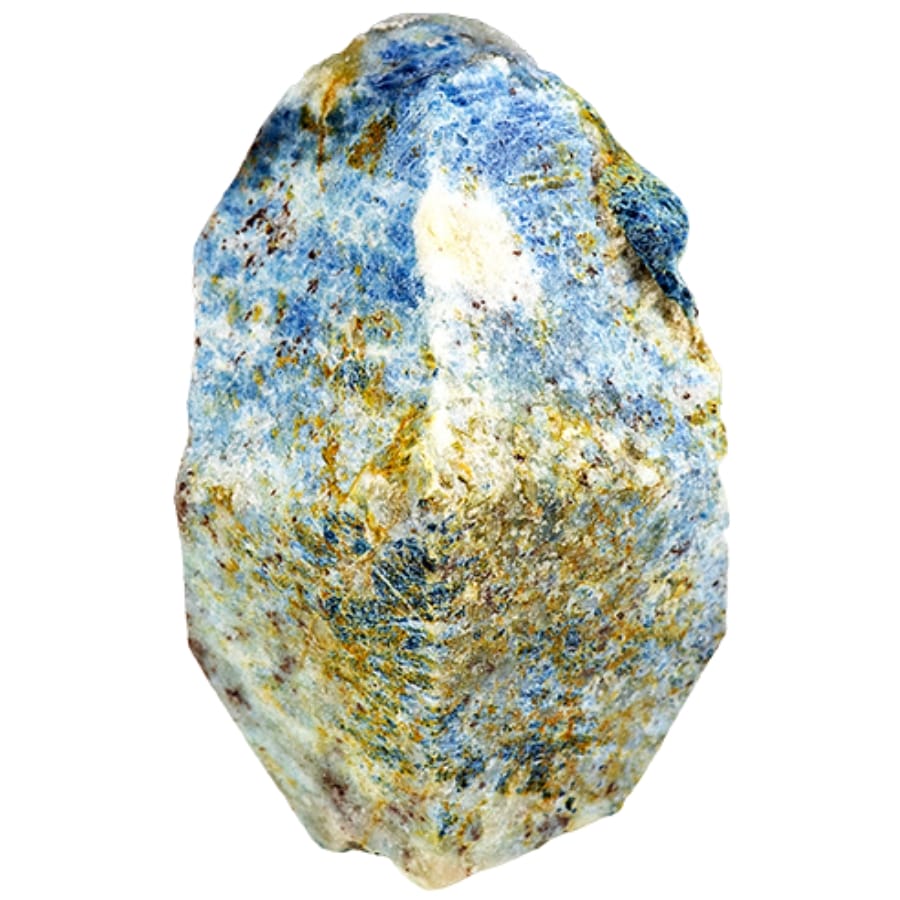
In some lights, lazulite can look a bit like sapphire because of its deep blue color. You can find magnesium, aluminum, phosphate, hydrogen, and oxygen in it.
Although lazulite isn’t as well known as turquoise or sapphire, it’s still a pretty cool blue gem. You can find it in different shades of blue, sometimes with a hint of green. It generally forms in small, crystalline shapes.
The blue color of lazulite can stand out even more when it is found with quartz or other rocks.
Most people value lazulite for how beautiful it is and how rare it is. Gemologists still respect it, even though it’s not often used in jewelry because it’s hard to find and not as soft as some other gemstones.
Others think that lazulite can help with things like meditation and can also be used for gathering. Its deep blue color is often linked to calmness and peace.
Because of this, lazulite isn’t often found in jewelry shops, but people who like unique and beautiful minerals really like it.
Where you can find Lazulite in South Carolina
You can find lazulites in the following places across the state:
- Henry’s Knob
- Worth Mountain
Sapphire
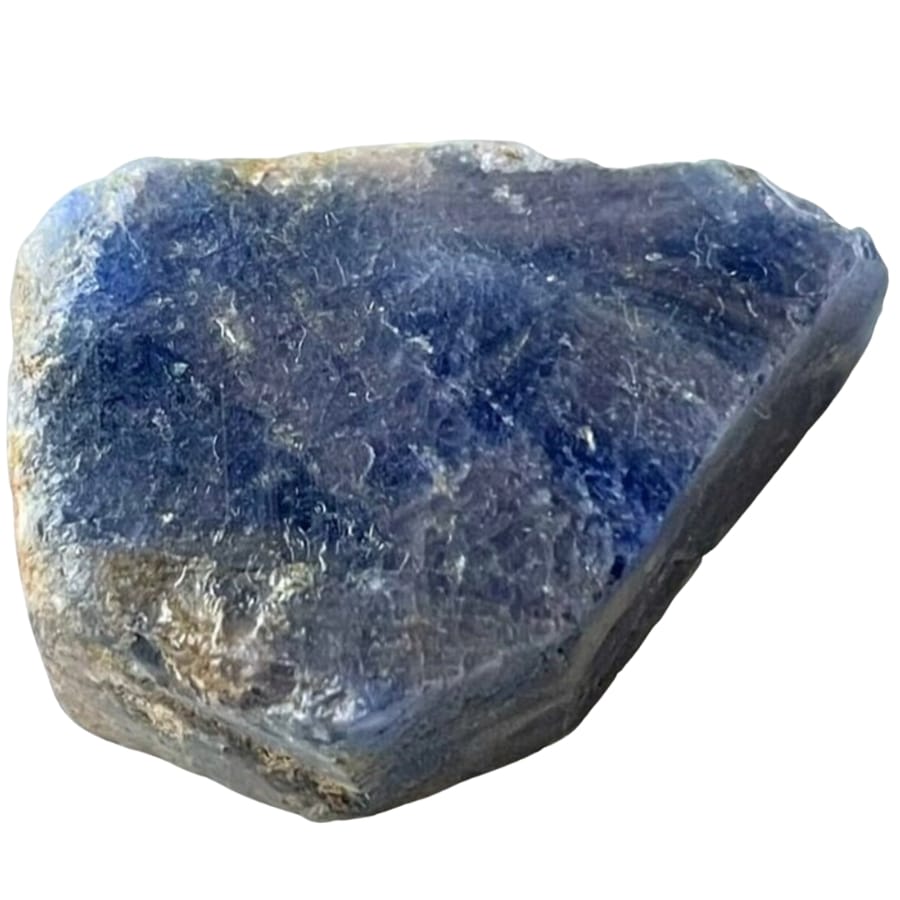
Sapphire is a well-known rock that is best known for its beautiful blue color. But did you know that it also comes in pink, yellow, and even clear? A sapphire is a type of the crystal corundum, which is mostly made up of aluminum oxide.
Tiny amounts of other elements, such as iron, titanium, or chrome, give the rocks their different colors. Most people like blue sapphires. They get their color from iron and titanium.
These gems are very hard, almost as hard as diamonds. This makes them great for making all kinds of jewelry.
Sapphires are very valuable because they’re pretty and strong, which is why people have loved them for a long time. People love them because of their long-lasting quality, which makes them great for everyday use.
A lot of rings, earrings, and bracelets are made with it, and can be used for more than just jewelry. They are so hard that they are sometimes used in scientific tools, windows that last a long time, and even electronic watches.
Where you can find Sapphire in South Carolina
All over the state, you can find sapphire in the following places:
- Bowen’s River
- Broad River
- Coastal Gem Mining
- Greenville Gemstone Mine
Sillimanite
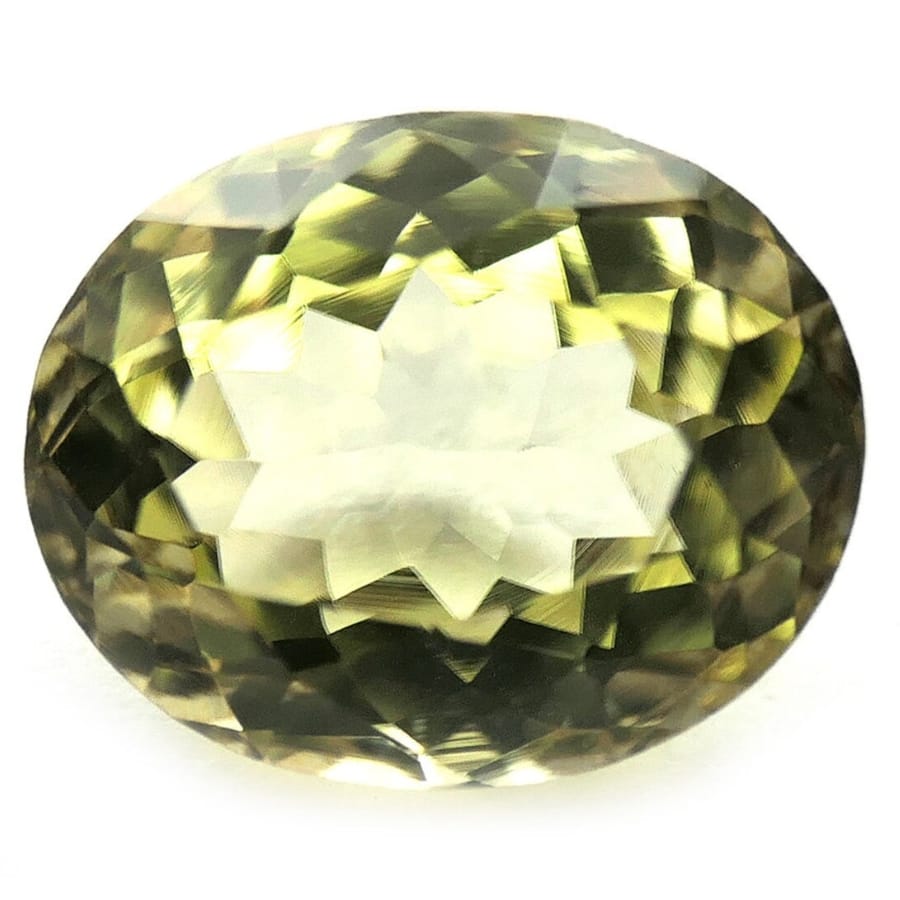
Another interesting mineral is sillimanite. It’s made of aluminum silicate, which is a mix of oxygen, silicon, and aluminum for the most part. A lot of the time, it’s white, brown, or green.
It comes in two different forms: long, thin crystals and more flexible forms that look like a bunch of tiny threads woven together. There isn’t much that can scratch or break it because it’s pretty tough.
A number of things make sillimanite valuable. The first way it’s used is in industry, where its hardness and ability to handle heat make it useful. One use is to make materials that line furnaces and kilns, places where it’s important to have strong materials that can handle high temperatures.
Sillimanite is a gemstone that is liked by fans and is sometimes used to make jewelry. Another gem that isn’t as well known, but has a unique look and can catch the light in interesting ways.
Even though sillimanite isn’t a well-known stone, it has its own place in the rock and jewelry worlds.
Where you can find Sillimanite in South Carolina
Many places in the state have sillimanite minerals, such as these:
- King’s Creek
- Paris Mountain State Park
Topaz
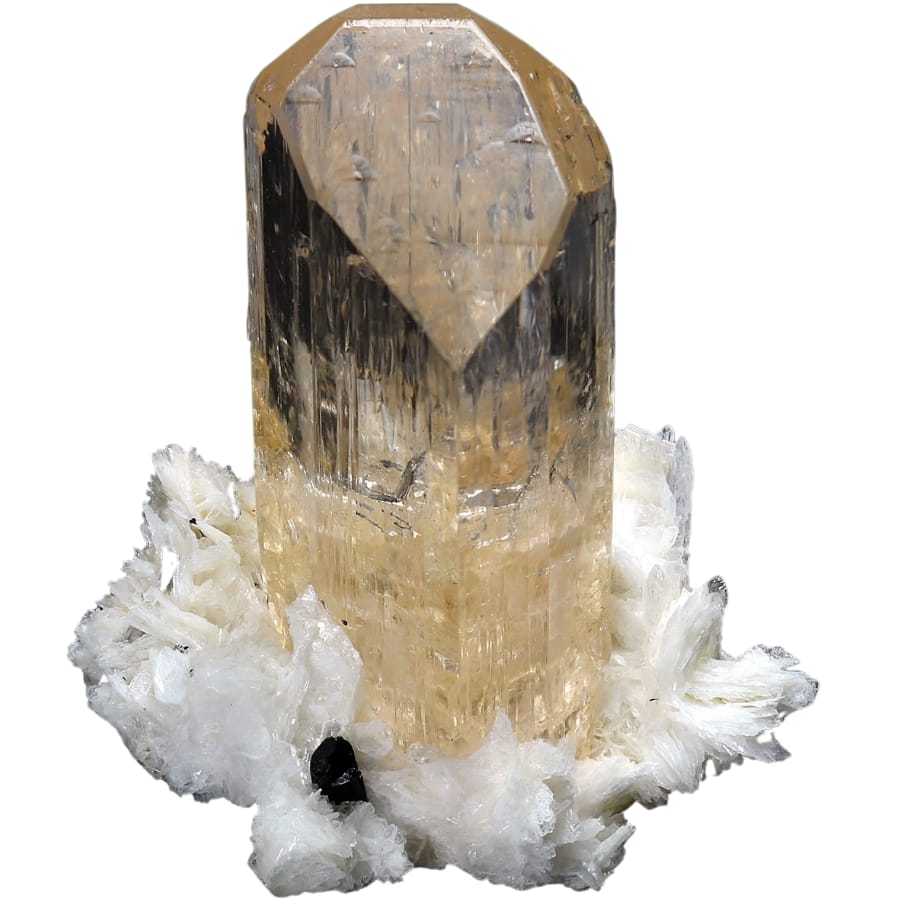
Topaz is a lovely rock that can be blue, yellow, pink, or even clear. It’s a mineral made of aluminum, silicon, oxygen, and fluorine. Topaz has many colors because it contains small amounts of other elements or because heat or other things can change its structure.
It has been a favorite stone for a long time because it’s both beautiful and very hard. It’s one of the hardest gemstones that comes from nature. Of course, this makes it great for rings, bracelets, and earrings.
Topaz is a valuable jewelry and is often given as a gift for important events like birthdays and weddings. A lot of people like blue topaz in particular. Along with being used in jewelry, it’s also collected by people who like gems.
Where you can find Topaz in South Carolina
You can find a lot of topaz in South Carolina in places like these:
- Bowen’s River
- Broad River
- Greenville Gemstone Mine
- McConnell Mica Prospect
The Crystals Found In South Carolina
Crystal and gem lovers will find a lot of beautiful gems in South Carolina that are worth a lot of money. We’ve written a lot about these crystals below.
You can read our in-depth article about where in South Carolina you can find crystals:
Amazonite
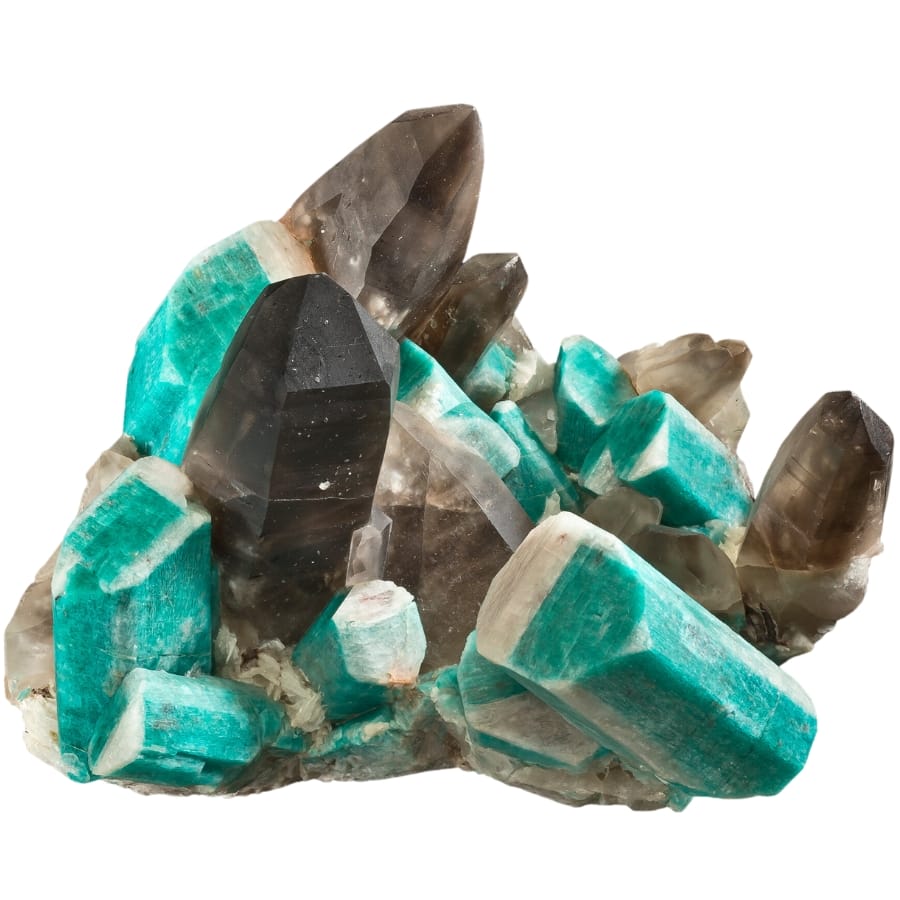
Amazonite is a fabulous gem that is known for its gorgeous turquoise-green color. It’s a type of feldspar, a group of rocks that make up much of the Earth’s crust. The unique green color of it comes from tiny amounts of lead and water in its structure.
Every piece of amazonite is unique because it looks different because it can have white or gray streaks going through it creating a glassy or shiny look.
The word “amazonite” comes from the Amazon River in South America, where people used to believe it was discovered, but this is not the case. Nonetheless, the term survived since the stone’s color resembles the rich green of the Amazon jungle.
Amazonite is valued for its beautiful color. It’s frequently used in necklaces, bracelets, and earrings. Its cool green tint can remind people of tropical waters or a quiet forest.
While amazonite is not as well-known as some other gemstones, it has a unique attraction to individuals who love its brilliant color and smooth, gleaming appearance.
Where you can find Amazonite in South Carolina
Amazonite can be found in South Carolina on these sites:
- Willimon Mine
Beryl
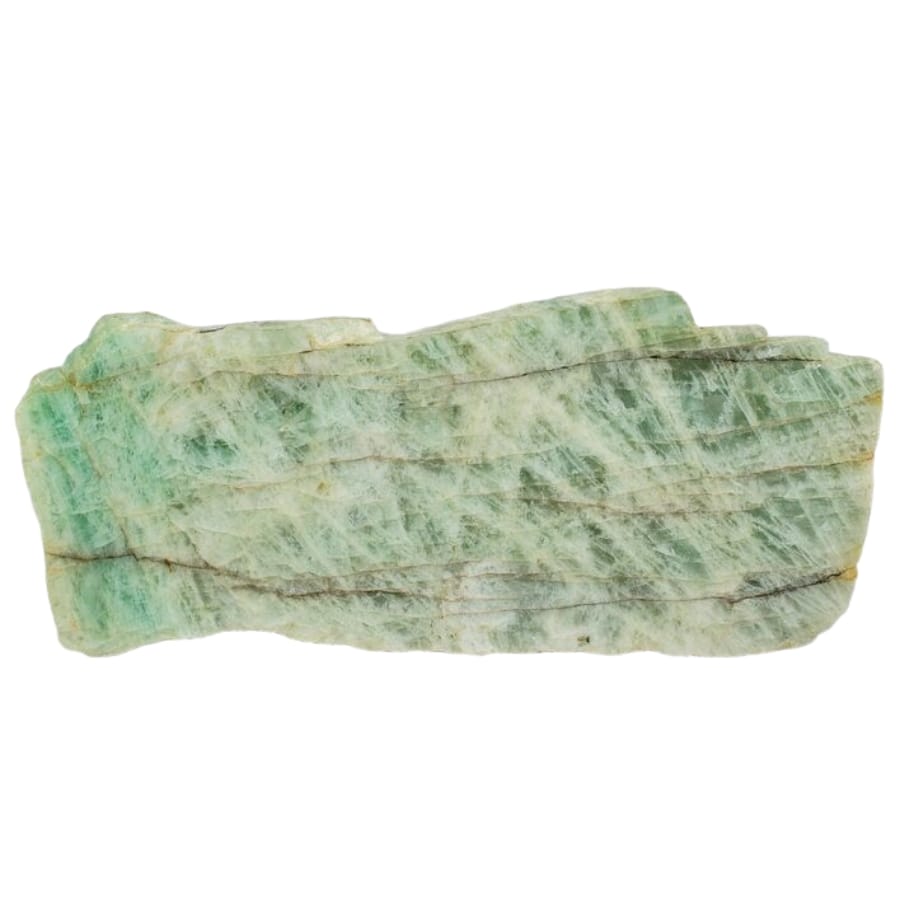
Beryl is a fascinating mineral, the family name for certain well-known jewels such as emeralds and aquamarines.
It’s typically a transparent or pale-hued crystal, but when impurities are present, it can transform into those lovely colored gemstones.
The term “beryl” derives from some ancient languages, including Latin and Greek, where it was known as “beryllus” and “beryllos,” respectively, and referred to a “precious blue-green color-of-sea-water stone.”
This demonstrates how long Beryl has been known and admired.
It can be found in rocks such as granite and pegmatites and metamorphic rocks, which have transformed over time due to heat and pressure. Its crystals can grow quite large and are frequently transparent and bright.
People value beryl for a variety of reasons. It’s a beautiful and clear crystal in its pure form, but it becomes unique when combined with other colorful gemstones.
Emeralds, a type of green beryl, are prized for their rich color and scarcity. Blue aquamarines are prized for their pure, sea-water-like tint.
Because they are both gorgeous and durable, these gemstones are frequently used in jewelry such as rings, necklaces, and earrings.
Beryl and its variants aren’t simply beautiful; they’ve also had historical and cultural significance, symbolizing youth, love, and hope.
Where you can find Beryl in South Carolina
Beryl is common in South Carolina, particularly in the following areas:
- Diamond Hill Mine
- McConnell Mica Prospect
- Paris Mountain State Park
- Savannah River Bank
Kyanite
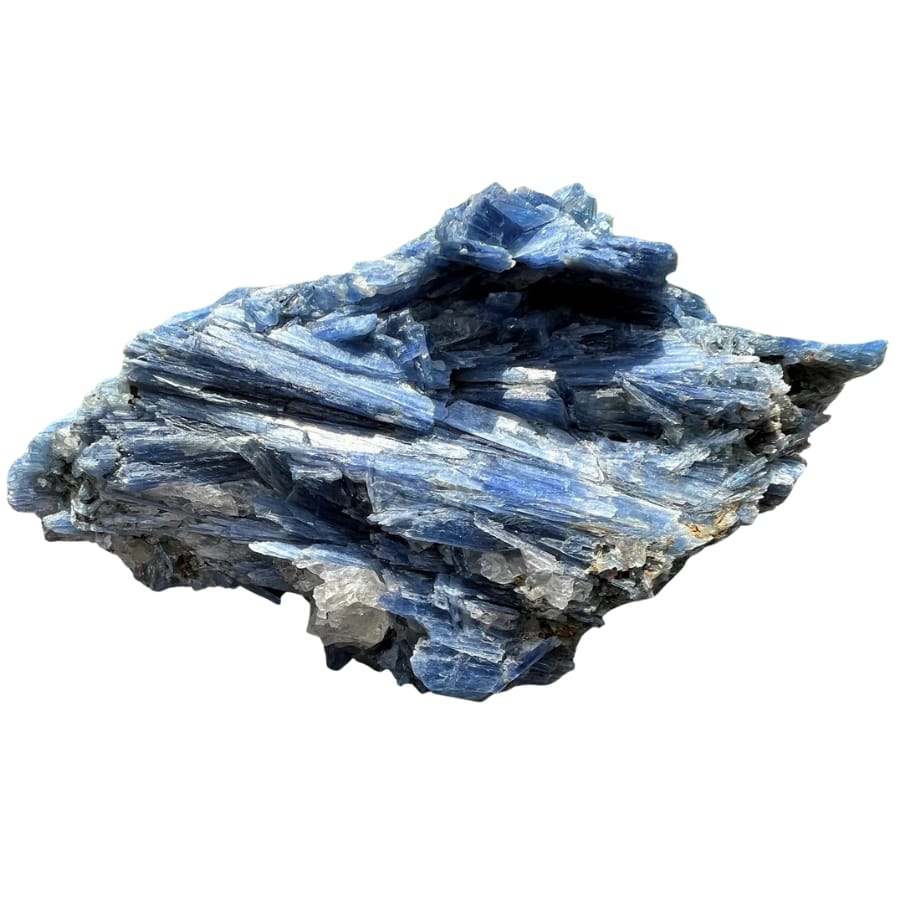
Kyanite is a fascinating mineral recognized for its deep blue color, similar to sapphire. The word “Kyanite” is derived from the Greek word “kyanos,” which means “deep blue.”
However, it can also be found in different colors such as green, orange, and black. It’s remarkable because contains two different hardnesses in a single crystal. It’s hard when scratched one direction, but softer when scratched another.
This is due to how its crystals grow, similar to how wood has variable hardness along and across its grain.
Kyanite begins as clay, and as the Earth’s plates move and squeeze these rocks, the heat and pressure change the clay into kyanite. Sometimes, large chunks can be discovered in these rocks, but they are usually in smaller, blade-like crystals.
Kyanite is valuable for a variety of reasons. Its lovely blue color makes it attractive in jewelry, such as necklaces and earrings. It’s not as intricate as some other jewels, so it must be cut and handled carefully, but its unusual appearance makes it worthwhile.
It also has some interesting industrial uses other than jewelry. It’s utilized in ceramics and electronics since it can resist high temperatures and doesn’t expand much with heat.
Where you can find Kyanite in South Carolina
Kyanite is abundant in South Carolina, notably in the following areas:
- Anderson Quarry
- Henry’s Knob
- King’s Creek
- Lake Murray Dam
- Worth Mountain
Rutile
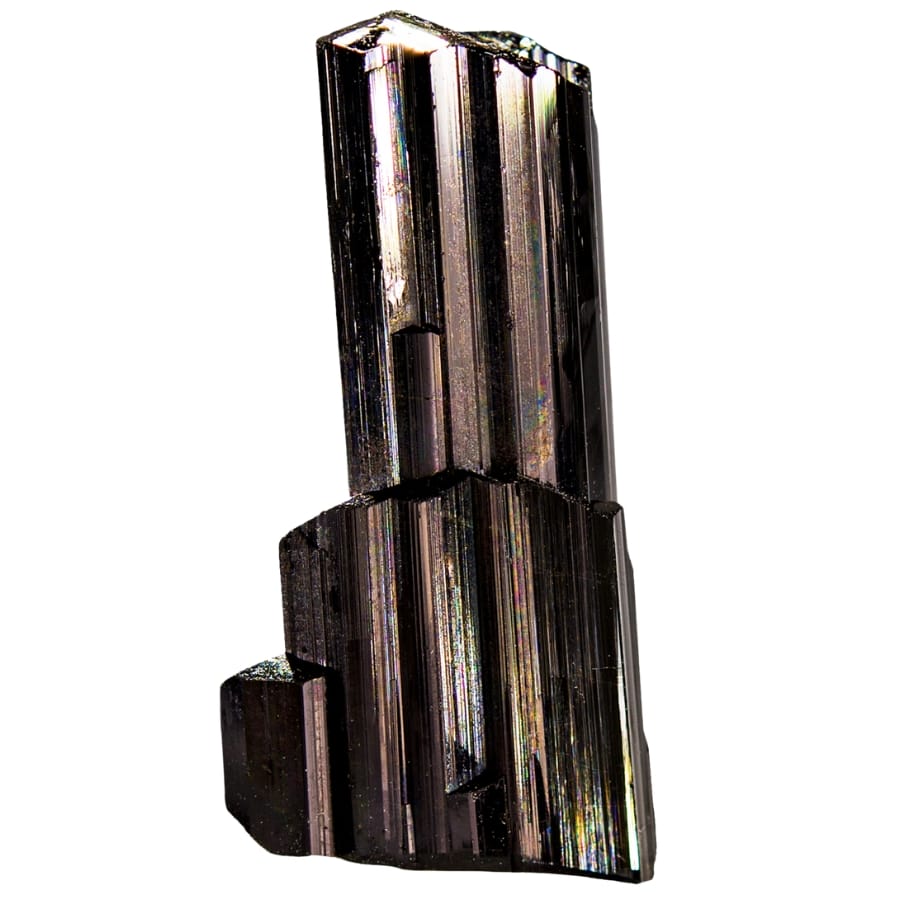
Rutile is a fascinating mineral known for its needle-like crystals and golden-red tint. The term “rutile” is derived from the Latin word “rutilus,” which means “reddish.” This makes sense because many rutile crystals are reddish or deep golden.
It’s composed of titanium dioxide, and it can be seen growing inside other minerals, such as quartz, which can be very interesting. Its crystals, like tiny needles, are frequently long and thin and can be highly shiny.
Rutile is pretty common and can be found worldwide, often in sandy deposits or rocks like granite and limestone.
People value rutile for many reasons. For starters, it’s a significant source of titanium used in various products such as airplanes, golf clubs, and even paint. Its titanium content makes it ideal for various industrial applications.
Rutile’s needle-like crystals are quite popular in the gemstone field. When these crystals are embedded in other stones, such as quartz, they make the stones appear more brilliant and intriguing.
Where you can find Rutile in South Carolina
South Carolina is rich in rutile minerals, particularly in the following areas:
- Bowens River
- Clearwater
- Perry Gravel Company
- Prosperity area
- Willimon Mine
Tourmaline
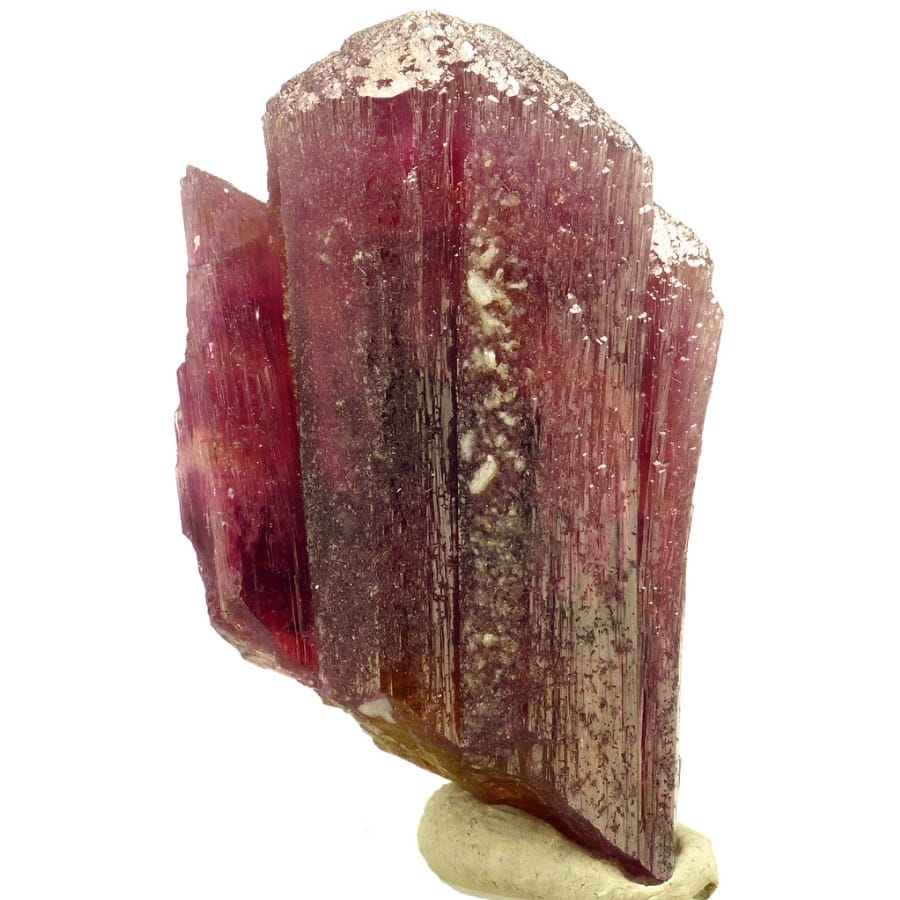
Tourmaline is a delightful gemstone that comes in about every color imaginable, from black to pink, green, blue, and even watermelon (which is green on the outside and pink on the inside, just like the fruit).
The term “tourmaline” is derived from the Sinhalese word “turmali,” which was used to describe mixed-colored stones in Sri Lanka.
A single crystal can have several colors because of chemical changes throughout its growth, which is extremely rare and unique in the world of gemstones.
Tourmaline is valued for its vast spectrum of colors and beauty. It’s widely utilized in jewelry, like as rings, necklaces, and earrings. Because it comes in so many different colors, each piece of jewelry made from it is unique.
Tourmaline is used in jewelry and collected by gem enthusiasts who appreciate its distinctiveness and the way it demonstrates how magnificent and diverse nature can be.
Where you can find Tourmaline in South Carolina
South Carolina has several tourmaline deposits, particularly in the following areas:
- Cowpens Mica Mine
- Davis Prospect
- Henry’s Knob
- Paris Mountain State Park
Zircon
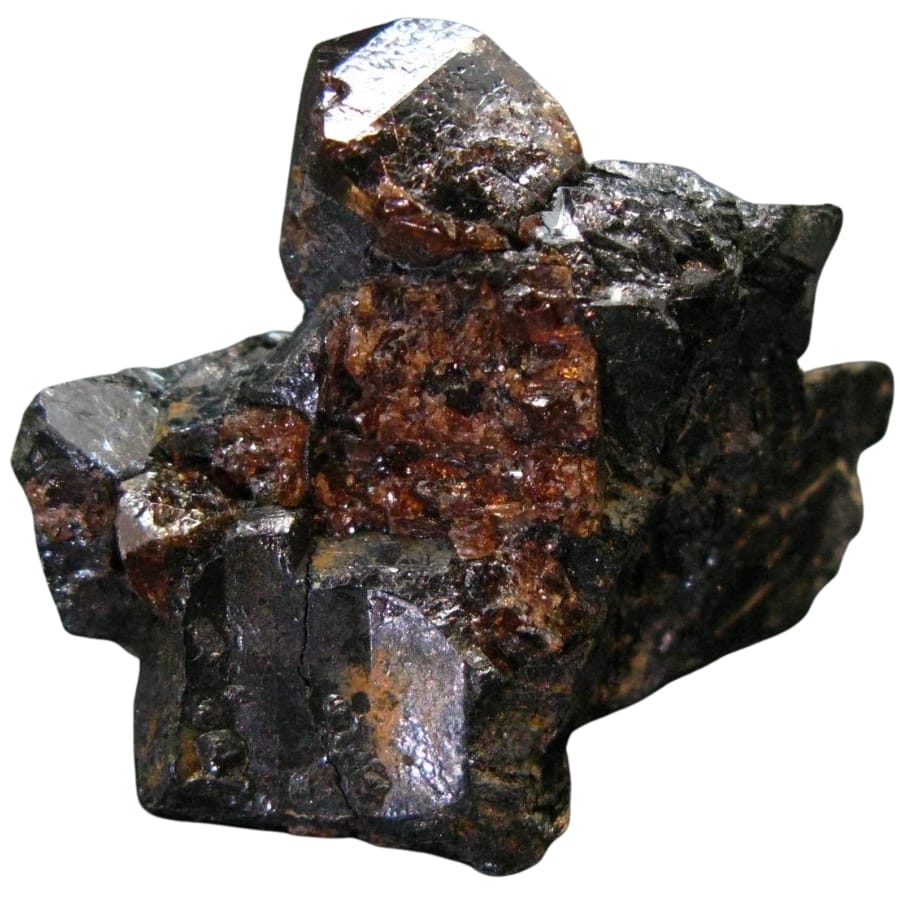
Zircon is a fascinating gemstone recognized for its brilliant and gleaming appearance. It’s available in a variety of colors, including blue, red, brown, and even clear.
The name “zircon” is thought to be derived from the Persian word “zargun,” which means “gold-colored.” However, not all zircons are gold-colored; they can be a variety of colors.
It’s frequently confused with cubic zirconia, a man-made diamond look-alike, but natural zircon is a distinct and one-of-a-kind gemstone. It’s one of the oldest minerals known on Earth, which makes it quite unique.
Zircon is valuable for several reasons. For starters, it’s really sparkling and lovely, thus it’s frequently used in jewelry including as rings, necklaces, and earrings. Clear zircons can resemble diamonds, making them a popular choice for those seeking a diamond-like appearance at a lower cost.
Where you can find Zircon in South Carolina
It’s easy to find it in the state, especially in these areas:
- Broad River
- Catawba River
- Clearwater
- Perry Gravel Company
The Most Valuable Rocks and Minerals in South Carolina
Now we’ll talk about the most valuable rocks found in the state. These rocks and minerals can help you achieve more money if you locate them:
Amethyst
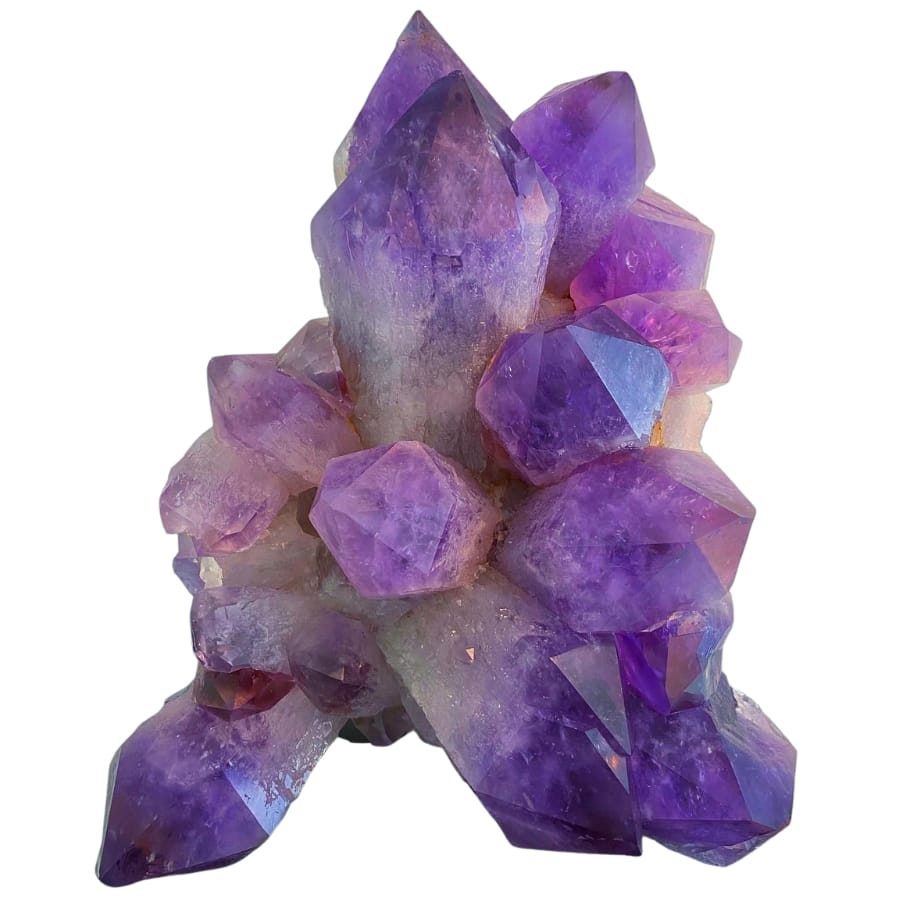
Amethyst is a lovely gemstone recognized for its deep purple color. “Amethyst” is derived from the Greek word “amethystos,” which means “not intoxicated.” People used to believe that wearing amethyst would keep them from getting drunk.
It’s a form of quartz, a common mineral, but its purple color distinguishes it. The hue ranges from a light, almost pinkish purple to a deep, rich purple. Minerals with different purple-colored layers are sometimes seen in the same stone.
Because of its beauty and scarcity, it’s one of the most precious minerals in South Carolina. The state is well-known for producing some of the highest-quality amethysts in the country.
Amethysts are highly prized for their deep color and clarity, making them desirable. It’s commonly used in rings, necklaces, and bracelets. It’s also the February birthstone, so it’s a popular present for anyone born that month.
Where you can find Amethyst in South Carolina
You can locate one-of-a-kind amethyst specimens in the following locations:
- Clearwater
- Diamond Hill Mine
- Ellis-Jones Amethyst Mine
- Lake Murray
- Shoals Junction
Blue Granite
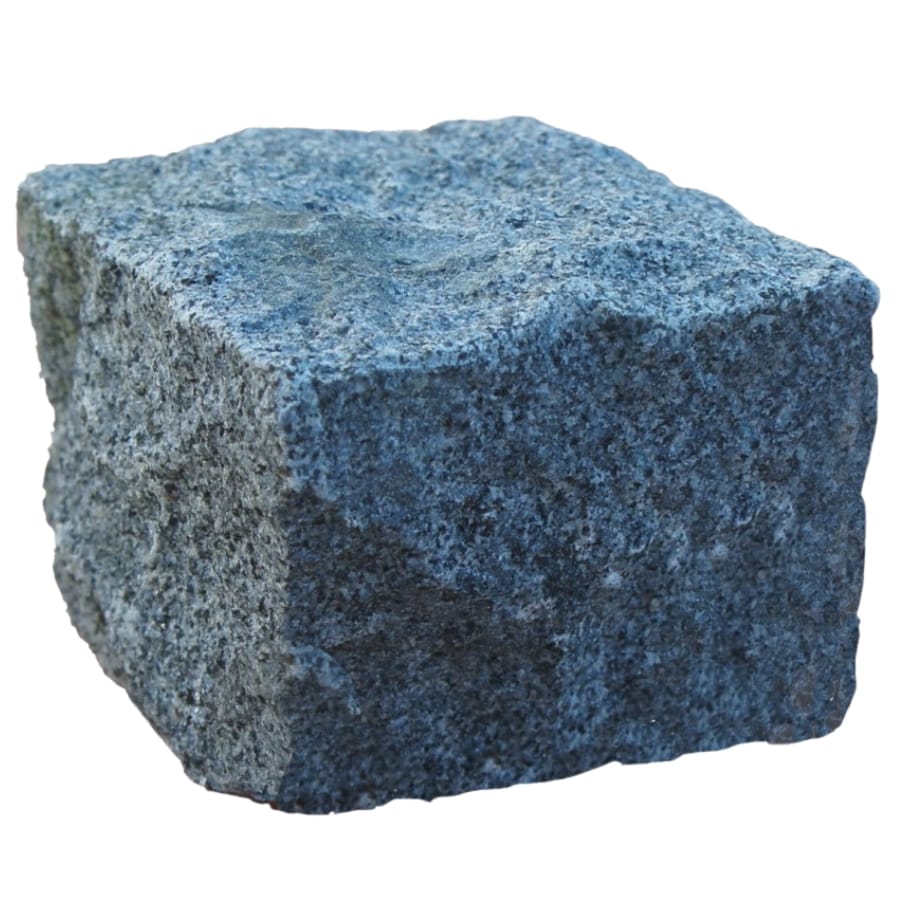
Blue granite is a beautiful type of rock that is predominantly found in South Carolina. It’s termed “blue” granite because it contains bluish minerals that give it a distinct tint. It’s not entirely blue, though; there are flecks of white, gray, and black as well.
The word “granite” derives from a Latin word that means “grainy,” which describes the appearance of the rock. Granite is composed of many minerals such as quartz, feldspar, and mica that have been combined together.
Blue granite gets its blue color from minerals like labradorite, which can appear blue or even greenish-blue when the light hits it just right.
Blue granite is extremely precious and unique in South Carolina. It even serves as the official state stone! South Carolina is noted for its high-quality blue granite, which is known for its strength and beauty.
It’s used for a variety of purposes, including construction and decoration. Because it’s so sturdy and does not wear down readily, it’s ideal for counters, floors, and outdoor locations. It also looks great with its distinct blue dots.
Where you can find Blue Granite in South Carolina
The Winnsboro quarry, where blue granite is extracted, is one of the oldest continuously operated quarries in the United States.
This quarry and others in the area have supplied blue granite for many significant building projects and monuments. Not only is it an important material locally, but it has also been used in construction projects nationwide.
Unakite
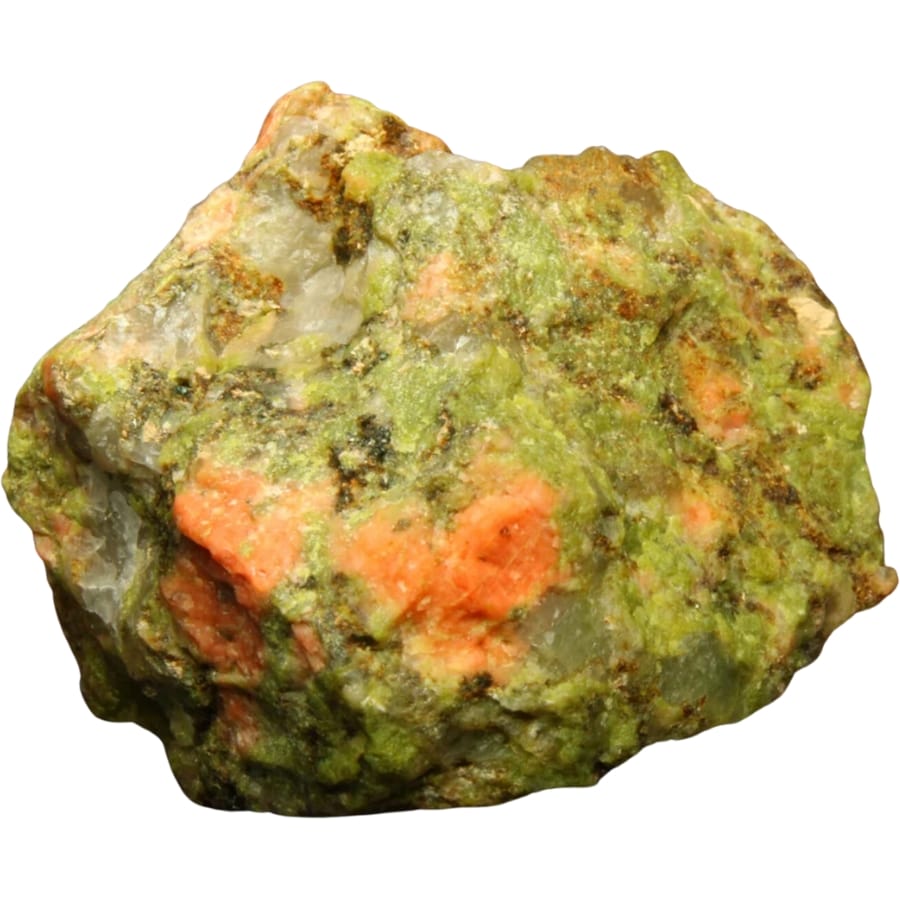
Unakite is an unusual rock composed of green epidote, pink orthoclase feldspar, and clear quartz. With its various hues mingled together, it resembles a mosaic.
The term “unakite” is derived from the Unaka mountain range in the southeastern United States, where it was discovered.
It’s mostly green and pink, which distinguishes it from other rocks. These hues are caused by the minerals found in unakite: the green is epidote, and the pink is feldspar.
It can be found in regions where there were once mountains or where rocks have been squashed and heated, such as parts of South Carolina.
Unakite is recognized in South Carolina for its beauty and distinctiveness. Although it is not as well-known as jewels such as diamonds or rubies, people admire its beautiful hues and patterns.
It’s commonly used in jewelry, such as beads for bracelets and necklaces. It’s also popular among rock and mineral collectors because it’s unique and not something you see daily.
Where you can find Unakite in South Carolina
Unakite can mostly be found at Lake Greenwood in the state.
How to Identify The Rocks and Minerals You Find
There are many reasons why it’s essential to be able to tell rocks and minerals apart. People use it to learn about the geological past of a place, figure out how critical mineral deposits might be, and enjoy the beauty and variety of what Earth has to offer.
It can be hard to tell what kind of mineral something is because there are so many. You need to be able to observe, know how materials are made, have good resources, and sometimes try out new tools to do this.
Observe physical characteristics
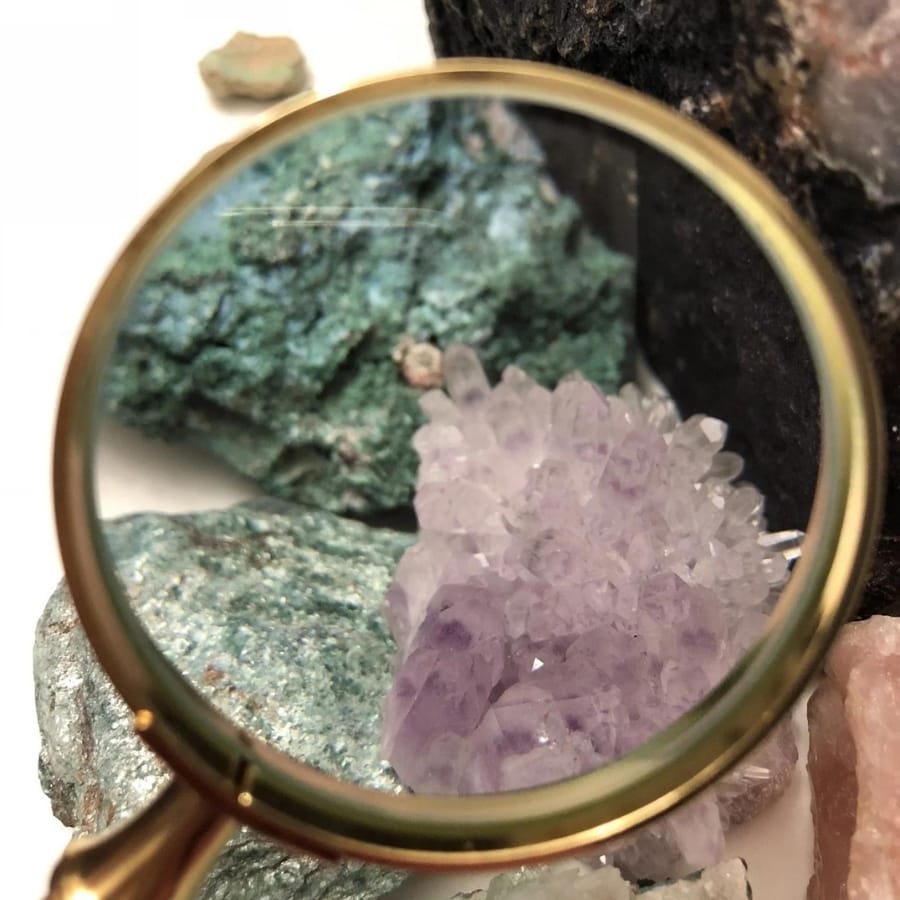
Observing the appearance of a rock, gem, or mineral is like being a detective looking for clues. It’s about noticing all the little details that tell you what it is and how it formed.
The first thing you usually notice is the color. Some minerals have very distinctive colors. Remember, the color can give you hints about the mineral.
See if the mineral is transparent (you can see through it), translucent (light passes through it, but you can’t clearly see through it), or opaque (no light passes through). Gems like diamonds are often transparent, while others like opal can be translucent.
If the mineral is crystalline, look at the shape of the crystals. This can be a key identifier.
Some minerals have unique lines or patterns on their surfaces, called striations. Others might have bands of different colors or unique inclusions (tiny materials trapped inside the mineral).
Remember, always handle rocks, gems, and minerals with care, especially if they’re not yours. If you’re not sure about something, it’s okay to ask an expert or do some research. Observing these details can be a fun way to learn more about the natural world!
Do a streak test
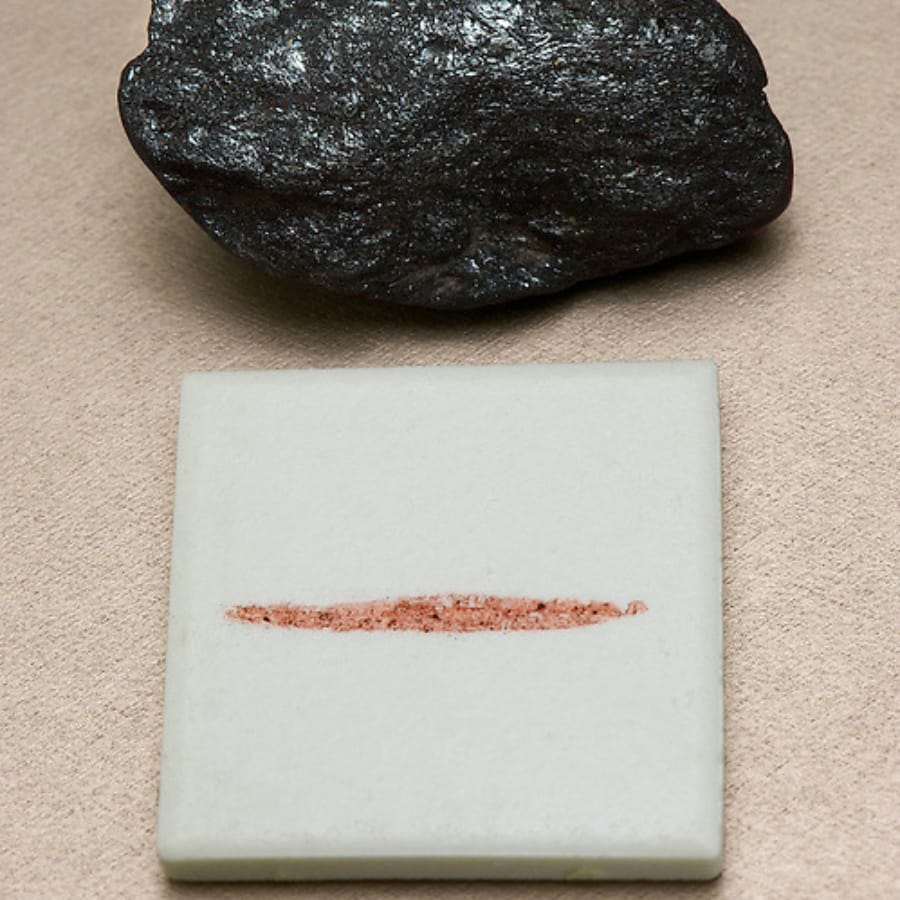
Doing a streak test on a rock, gem, or mineral is a simple way to learn more about its properties. The streak test shows the mineral’s color in powdered form, which can be different from the mineral’s color.
A streak plate is usually a piece of unglazed porcelain tile. It’s important that the plate is unglazed, as the rough surface is needed to powder the mineral. These plates are often white, but you can also find black plates for testing light-colored minerals.
Make sure the mineral is clean and free of dust or dirt. You want to test the actual mineral, not any dirt that might be on it.
Hold the mineral and firmly rub it across the streak plate. You don’t need to press too hard, just enough to leave a streak of powder on the plate. If the mineral is harder than the streak plate (like a diamond), it won’t leave a streak.
Look at the color of the streak on the plate. This is the true color of the mineral.
The streak test is a great tool for identifying minerals, but is just one part of the puzzle. It would be best if you often looked at other properties like hardness, luster, and crystal shape to identify a mineral fully.
Perform a light test
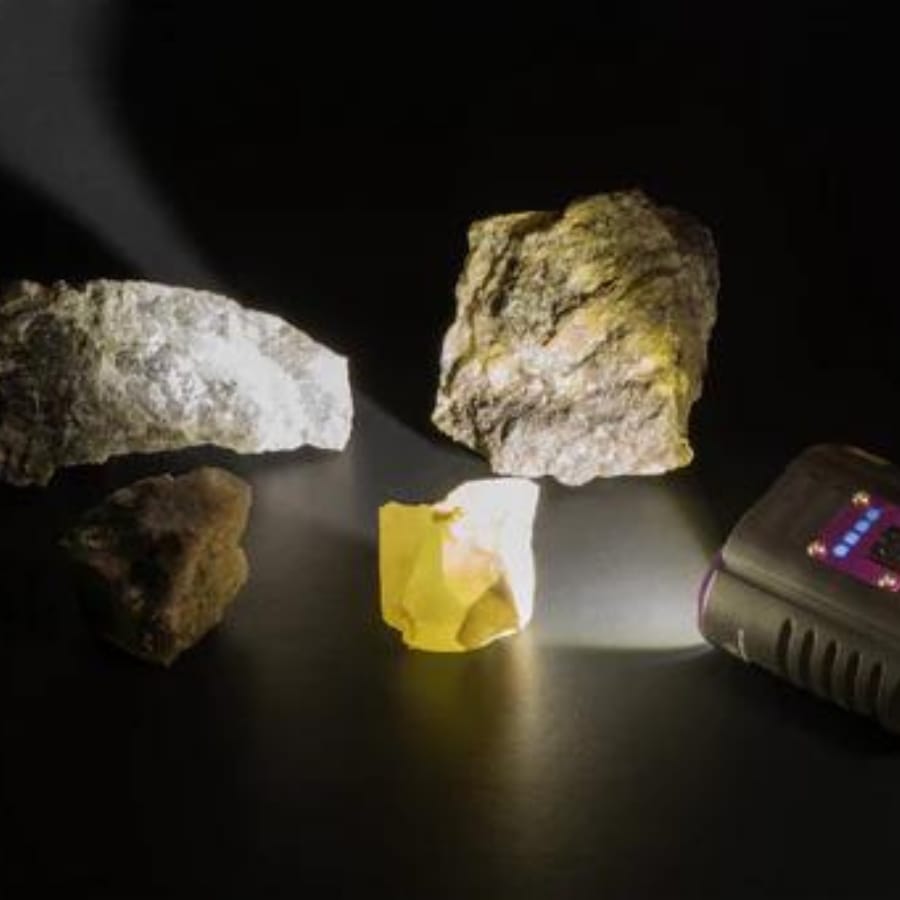
Performing a light test on a rock, gem, or mineral is a great way to observe some of its unique properties, especially transparency, clarity, and optical phenomena.
You’ll need a good, strong light source. This could be a bright lamp, a flashlight, or direct sunlight. The key is to have a bright light to pass through or reflect off the mineral.
Before using your artificial light source, look at the mineral in natural light. Notice its color, luster, and any surface features. This gives you a baseline for comparison.
Hold the mineral to the light source and see if it passes through it. This will help you determine if the mineral is transparent (light passes through clearly), translucent (light passes through but not clearly), or opaque (no light passes through). For example, quartz is often translucent to transparent, while pyrite is opaque.
Some minerals can change color or show special effects under light. Be careful not to use a light source that’s too hot, as it could damage the mineral or cause it to fracture, especially if the mineral has been treated or has natural internal stresses.
A light test can reveal a lot about a mineral’s optical properties and can be a fun and educational part of rock and mineral collecting.
Use online tools
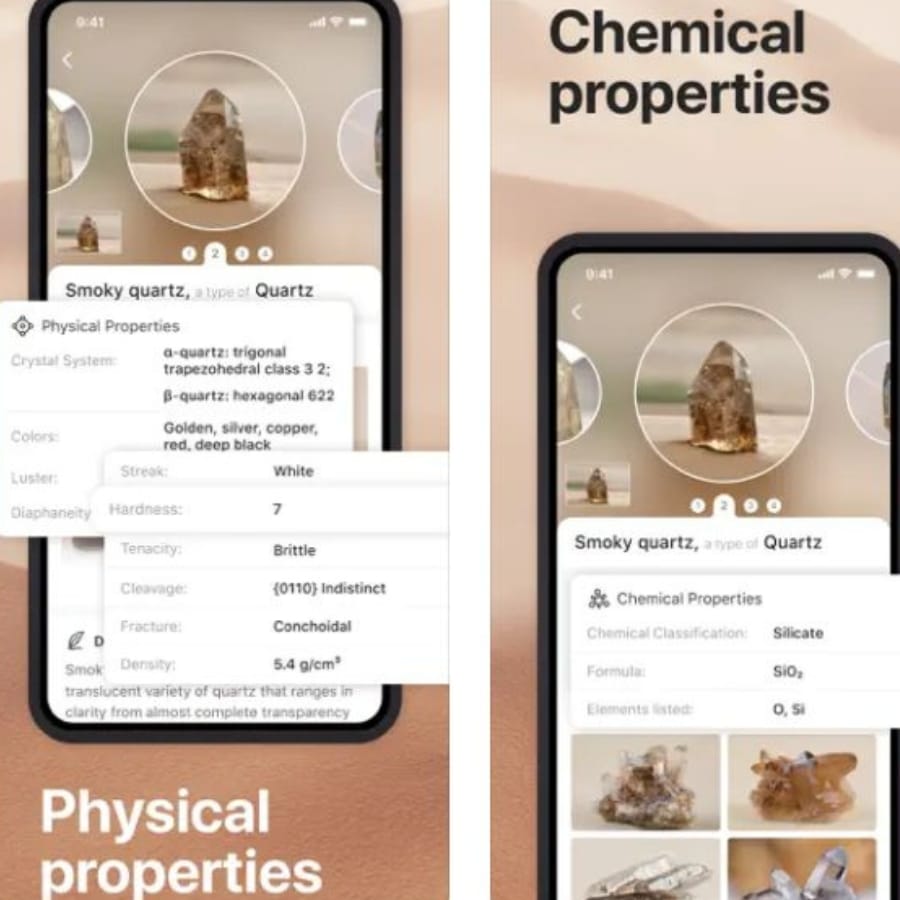
Using online application tools to identify a rock, gem, or mineral can be a helpful and convenient way to learn more about your specimen.
There are apps available where you can upload a photo of your rock, gem, or mineral, and the app uses image recognition software to provide you with potential matches.
These apps often have databases of images and information to compare against your photo. Examples include Mineral Identifier, Rock Identifier, and Google Lens.
There are many websites dedicated to geology and mineralogy that offer extensive information about different types of rocks, gems, and minerals.
It’s important to cross-reference information from multiple sources. Online tools can be incredibly helpful, but they’re not always 100% accurate, especially for complex or rare specimens.
Remember, while these online tools are useful, they may not always be accurate for every specimen, particularly those that are rare or have unusual features. Sometimes, the expertise of a geologist or a professional gemologist might be needed for a precise identification.

